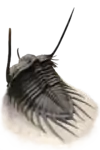| Librostoma Temporal range: | |
|---|---|
 | |
| Asaphus lepidurus | |
| Scientific classification | |
| Domain: | Eukaryota |
| Kingdom: | Animalia |
| Phylum: | Arthropoda |
| Class: | †Trilobita |
| Subclass: | †Librostoma Fortey, 1990[1] |
| Orders | |
| |
Librostoma is a subclass of trilobites defined by having a natant hypostome, which is a hypostome (mineralized trilobite mouthpart) that is free from the anterior doublure and aligned with the anterior of the glabella,[3] this is unlike a conterminant hypostome, which is attached to the exoskeleton.[4]
They are a large and long lasting group, with some of the candidates for the first trilobites being librostomes in the order ptychopariida; and all post-Devonian trilobites being in the order proetida, whom are librostomes.
The monophyly of the group has been questioned, with Whittington (2003) placing some genera (Hemibarrandia, Lakaspis, Peraspis and Symphysurina) of the asaphid family Nileidae in the order Corynexochida.[5]
Taxonomy
Librostoma make up a large component of the trilobita. Traditionally, four orders are placed in the librostoma; they are the: Asaphida, Harpetida, Proetida, and Ptychopariida; however, two primitive Phacopids (Pharostomina and Bavarilla) have natant hypostomes, indicating that the phacopids are also librostomes.[6] In more recent publications, the asaphid superfamily Trinucleioidea is placed in its own order, trinucleida.[2][7]
Evolution
Origins
The first librostomes were Ellipsocephaloid Ptychopariida in the family biogtinidae from the early cambrian.[8] This group was once thought to be in the order redlichiida, but are now considered primitive ptychopariida.
Evolutionary history
During the middle cambrian, the Ptychopariida became the dominant trilobites.
The Asaphida and Trinucleida first appeared in the middle cambrian.
The first harpetida would appear in the late cambrian with the primitive genera Baikadamaspis and entomaspis of the family entomaspididae.
The first proetida appeared during the cambrian-ordovician transition. Since the earliest phacopida (which are most likely librostomes) appeared during the early ordovician, it is assumed that a late cambrian sister taxon was present.[6]
During the Ordovician, the ptychopariida declined. After the decline of the ptychoapriida, the Asaphida rose to prominence, becoming the dominant order of trilobites by the end of the mid-ordovician.
See also
References
- ↑ Ontogeny, hypostome attachment and trilobite classification. RA Fortey, Palaeontology, 1990
- 1 2 Bignon, Arnaud; Waisfield, Beatriz G.; Vaccari, Emilio; Chatterton, Brian D. E. (2020). "Reassessment of the Order Trinucleida (Trilobita)". Journal of Systematic Palaeontology. 18 (13): 1061–1077. Bibcode:2020JSPal..18.1061B. doi:10.1080/14772019.2020.1720324. S2CID 212995185.
- ↑ "The Hypostome".
- ↑ Whittington, H. B. "REFLECTIONS ON THE CLASSIFICATION OF THE TRILOBITA". University of Cambridge.
- ↑ Whittington, Harry B. (2003). "The trilobite family Nileidae: morphology and classification". Palaeontology. 46 (4): 635–646. Bibcode:2003Palgy..46..635W. doi:10.1111/1475-4983.00313.
- 1 2 "Phacopida fact sheet". trilobites.info.
- ↑ "Trilobite order Trinucleioidea". trilobites.info.
- ↑ "The earliest trilobites".
External links
https://trilobites.info/Trilobites.info A guide to the orders of trilobites

.jpg.webp)
